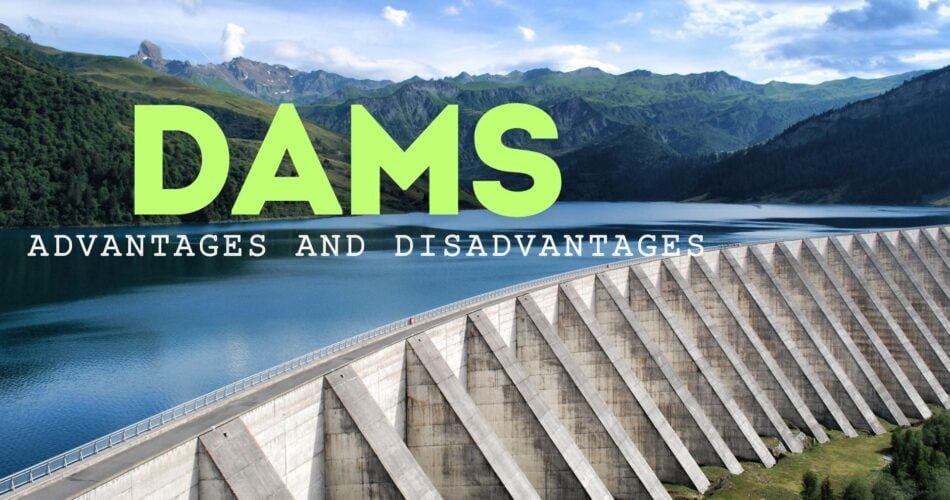This blog contains information about Dams. In the start, it discusses What is Dam and introduces a Dam. Then it mentions some important purposes of Dam Construction. It also explains the Types of Dams in detail. Then it elaborates Historical Dams. It also shines a light on the Environmental Impacts of Dams. In the end, it explains the Advantages and Disadvantages of Dams with detail. This blog contains Purposes, Types, Advantages and Disadvantages of Dams.
What is called a Dam?
Dam is a structure that is constructed across a stream or river to block the flow of water, creating a water reservoir. The most important function of dam is storing water to avoid crisis.
A Dam is built as a barrier that stops and stores normal flow of water from a Natural resource. It serves a lot of advantages in avoiding Water crisis of any region of the world. Most of the dams have a huge capacity to store water and protect it for future use.
Other than storage of water, dams also play a great role in generation of Power. We all know that we can generate Electricity from the kinetic energy created from high speed water flow. Dams are used to generate electricity with Renewable means of energy at large scale in developing as well as developed nation.
These are artificial water reservoirs that stores water to make it productive and so useful in the conditions of Water Scarcity, Flood, and other such water crisis and emergency situations.
With providing many advantages, Dams also contributes in many problems regarding aquatic species, biodiversity in certain area and other such factors are so dangerous for living systems and Natural Resource Management. We will discuss a complete overview on Dams Construction, Purposes, Advantages and Disadvantages.
Purposes of Dam Construction:
Following are few purposes or reasons to construct a Dam:
1. Flood Control:
As dams are spread over a large land area just for water storage, so in case of Floods, dam contributes by storing a large amount of water that can prevent flood. In severe cases, if it may not prevent floods, it will reduce the effects and damages of floods at great extents. This is the reason dams are constructed in areas with too much rainfall annually.
2. Rainwater Harvesting:
The areas with a lot of rain, uses dams to store the rainwater instead of being wasted into the drainage systems of the region. A huge amount of rainwater wastes and cause Urban Flooding in the cities. Dams stores the excessive water and this water is then used either for generation of electricity, household use, and for other major or minor purposes.
3. Irrigation and Water Supply:
Dam contains water that is supplied to the nearest residential areas including the agricultural lands and farmlands. The agricultural lands are irrigated and nourished by Dam water. It also helps in supply of water in the homes of farmers and other people living in the region. The water in the dam restores every time, when it rains and in this way there is a less chance of Water Scarcity in the area.
4. Hydroelectric Power Generation:
The gates that constructs on the Dam to stop the water flow, when gates opens to have high speed flow of water. The kinetic energy that creates from the speedy flow of water, runs the turbine. Then the turbine drives the generator and produces electricity. This electricity produces from Renewable and Sustainable form of energy. In this way power generation takes place on the Dams called the Hydroelectric Power.
5. Pollution Control:
Dams also in contributes in controlling the pollution through its function. As we know, dams stops the natural flow of Water resources, then it also stops solid wastes, chemical wastes and liquid wastes added into the water also stops by the barriers. This helps in tackling water pollution, land pollution and in some cases air pollution to transfer to other places.
6. Recreation:
As dams are artificial water reservoirs or resources, so they constructs with special design according to its proper working mechanism. They are worth looking at. Most of the dams are favorite picnic spots for the people of nearby areas. Many parks, restaurants, walking tracks etc. are on the dams and barrages where people enjoy their day with their loved ones and are beautiful to visit.
These are few purposes and reasons of Dam Construction.

Types of Dams:
Following are some basic types of Dams:
i. Diversion Dams:
Diversion Dams are the dams that works to divert water ways. These dams provide pressure to the water in order to divert the water flow according to the need. They have smaller storage and low height.
ii. Buttress Dams:
Buttress dams consists of sloping deck supported by intervals of buttress. These dams uses less concrete than other dams but are still expensive to built. They can be of many forms.
iii. Embarkment Dams:
Embarkment dams are made from natural excavated materials or industrial waste materials. These are artificial dams and are larger in size. They also use various compositions of soil, sand, rock or silt.
iv. Cofferdam:
Cofferdam is a temporary and portable type of dam that constructs for certain projects and also other purposes. These projects may be shoreline restoration, bridge construction, pipelines etc.
v. Storage Dams:
Storage dams are simply for storing water to use when there are water shortages and water crisis. These are used to supply water for Power generation, livestock and for Irrigation purposes.
vi. Detention Dams:
Detention dams are those dams that are constructed especially for the flood control purposes. The function of these dams are to store flood water to reduce damage and the water is released later.
vii. Gravity Dams:
Gravity dams are large dams that are of concrete in order to hold and store very large amounts of water. The gravity helps in holding the dam to the ground regardless of great pressure of water.
These are the 7 most basic Types of Dams.
Historical Dams:
There are many amazing historical dams in the world. Most of the dams in ancient times were gravity dams. But some of them have amazing architecture and safety features. These historical dams impress the present day scientists as they show water holding and water storing techniques and processes decades ago. A brief description of some Historical dams is given below:
Jawa Dam, Jordan:
Jawa dam is the most ancient dam on Earth. This dam came into being in 3000 BC so this dam was the architectural feat of its times. It was a dam that contains safety features that are mind blowing.
Lake Homs Dam, Syria:
It is the oldest operational dam in the world. It was built in 1300. The Lake Homs Dam is about one mile long and 23 feet height. This makes Lake Homs and supply water to people of Homs till today.
Environmental Impacts of Dams:
Following are some environmental Impacts of Dams:
. Soil Erosion:
A great level of soil erosion exists at the embarkments of the dams. The standing water takes away soil nutrients and also soil particles away with water and contributes in desertification and infertility near the embarkments of the dam. This can result in serious impacts.
. Species Extinction:
Dams also contributes in extinction of species. As we know that dams forms barriers in the natural flow of water. This not only stops the water but also stops the aquatic species and animals that needs to migrate to breed properly. In this way the reproduction of species is restricts and they become extinct.
. Spread of Diseases:
Standing of water in the dams can lead to the viruses and bacteria that gives rise to severe and fatal diseases. The diseases that originates from water are Water-borne diseases. These diseases such as Cholera spreads over nearby villages and residential areas and can harm the health of the people.
. Sedimentation:
As dams collects all the water that reach from the flow of river or stream, so it takes all the sediments by the process of erosion with it. This fills the dam with rock particles, nutrients and also soil particles. The process of sedimentation effect the storage capacity of dams with passing time.
. Managing Salinization:
Dams can play a great role in managing salinization by discharging saline water from the dam for different purposes. While if the discharge is less and slow in speed, it can increase the Water salinity. So, there is a need for proper precautionary measures to manage it.
.Water Logging:
Dams stores water and that water stays at the same location for years. This may cause water logging of the soil. The water logging of the soil may creates problems for agricultural and farming practices and can also disturb the life style of the people living around the dam.
. Conserves Water:
The main purpose of dams is to conserve water by avoiding its wastage and avoid to make it a part of drainage system and Water Pollution. Dams are sustainable source of conserving and storing water so that we can use it in the hour of need.
These are Environmental impacts of Dams. This blog contains Purposes, Advantages and Disadvantages of Dams.
Advantages of Dams:
- Facilitates us in Water Conservation and also in Rainwater Harvesting.
- Dams contributes in Flood control in every possible way.
- These helps us to generate Hydroelectric power that is extremely Sustainable, Renewable and Clean form of energy.
- It provide water supply for household and also irrigation practices.
- It helps in the pollution control by stopping all the pollutants.
- Dams serves as a perfect Recreational spot or also a picnic spot for the people of nearby areas.
- Dams helps in efficient utilization of water for useful purposes.
- These systems can help in managing Soil Salinity.
These are few advantages of Dams.
Disadvantages of Dams:
- Dams disrupts the natural flow of the rivers and streams.
- The supply of nutrients for the aquatic life blocks because of dams.
- Specie migration inhibits and it leads to Endangerment or Extinction of certain species and can cause disruption in local ecosystems.
- Standing water gives rise to Water-borne diseases such as Cholera, Typhoid etc.
- Dams play a great role in extreme levels of Soil erosion.
- They are very expensive to build.
These are few disadvantages of Dams. This blog contains Purposes, Advantages and Disadvantages of Dams.

To learn about more topics, Click the links below:
Ecology and Environmental Ecology
Future of Water Resources in Pakistan


Comments